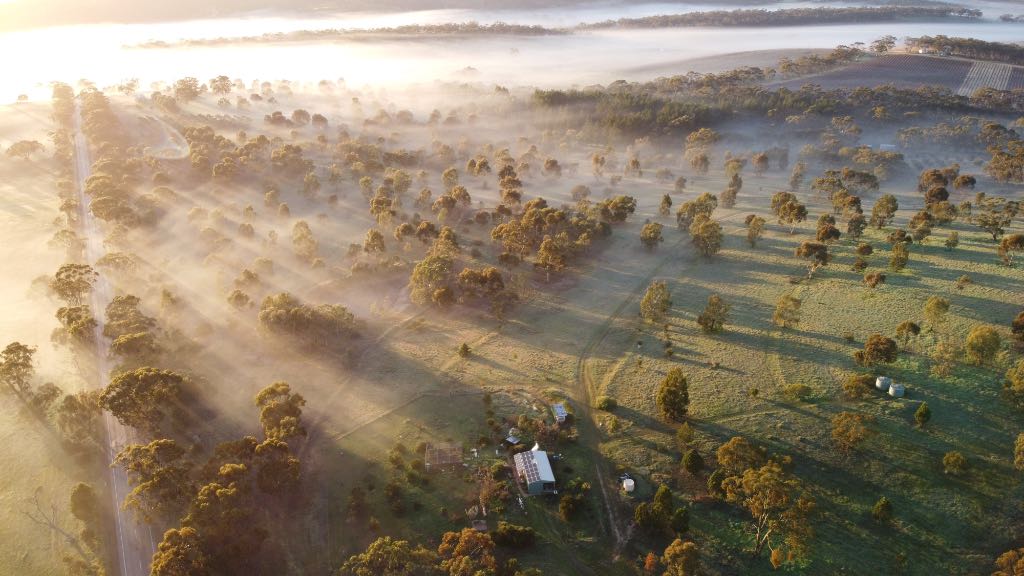
Over the years I've taken a great many photos of trees, or photos in which trees and shrubs made up an important part.
This page is intended to show some of my better tree photos. The great majority of the trees were in Australia, where I live and where I have spent about 77 of my 78+ years. Most of the photos have been copied from my other pages, together with some of the text. Apologies if some of the text seems a bit disjointed.
Contact: David K. Clarke – © |
For a time I had the privilege of caring for these trees and this land
|
|---|

|
I planted almost all the trees in the nearer area, other than those on the roadside |
Xanthorrhoea, a very atypical treeA 'grass tree', also known as a yacka (or yakka or yacca); botanical name Xanthorrhoea; they are endemic to Australia and are considered iconic.My beloved wife Denece noticed the view and suggested I took a photo of it. It was taken on one of the many times that we have climbed St Mary's Peak in the Flinders Ranges of South Australia and is one of my favourite photos. Xanthorrhoea are very slow growing, typically the trunk will grow at something like one or two centimetre a year, but I've recorded growth in the seed head of 9 centimetres per day.
Gum trees, the quintessential Australian treeIt would be remiss of me if I passed through the Introduction of this page without mentioning that most iconic of all Australian trees, the gum tree.The gum trees, or Eucalypts, include seven closely related genera (of the tribe Eucalypteae) found across Australia: Eucalyptus, Corymbia, Angophora, Stockwellia, Allosyncarpia, Eucalyptopsis and Arillastrum.
Karri trees (Eucalyptus diversicolor) in Shannon National Park, southwest Western Australia.
Trees in Kings Park, Perth, Western Australia
Kings Park again - Swan estuary in the background.
Trees, or limbs that have a mind of their own: Standing out from the crowd
This one limb of (I think) a lemon-scented gum (Corymbia citriodora) in Kings Park decided it wanted to go any direction but upward. It didn't want to do the normal, accepted, standard, ordinary, thing.
Photo iPhone 11 Pro, standard lens, 2024/01/18
Again, I think it's a lemon scented gum.
Photo iPhone 11 Pro, standard lens, 2024/01/03
Mandurah
There are four others scattered around Mandurah and one in Subiaco, Perth.
Several of the Giants have some association with trees (apart, of course, from the fact that all are made of wood). The other with a close association is the one in Marlee Reserve, 'Little Lue'; it is resting against the roots of a fallen tree.
The 'big seasonal paperbark swamp' (BSPS), Mandurah
I believe that most of the Eucalypts in the BSPS are marri (Corymbia calophilla), jarrah (Eucalyptus marginata) or tuart (Eucalyptus gomphocephala). I'm not good at telling one from another of these without seeing the seed capsule (the marri capsule is very large - nick-named honkey nuts - the jarrah and tuart capsules are much smaller). More experienced people can tell by the bark - see below.
Tuart (Eucalyptus gomphocephala) is another large similar looking Eucalypt that grows in the area. As noted in WA's Giant Trees tuart bark "is usually a light grey to nearly bone white in direct sunlight, to darker grey or brown in shaded conditions. The bark is rough, scaly and flaky, with irregular but attractive patterns."
|

|
|
Roley Bushcare has a page on identifying 'Marri versus Jarrah', the above image was taken from that page.
|
Xanthorrhoeas in the big seasonal paperbark swamp (BSPS)
Curiously there is very little middle story undergrowth in the BSPS while the part of the Len Howard Conservation Park that is close to the Peel lagoon is densely covered with undergrowth, to the point where much of it is difficult to walk through. In the BSPS there are grasses and low groundcovers, some rushes in places and there are the trees; very few shrubs. There are some grass trees (Xanthorrhoeas) and Zamia palms (Macrozamia riedlei) in the more open areas.
Photo iPhone 11 pro, 4.25mm standard lens, early morning 2023/01/02.
A particularly big paperbark tree in the 'big seasonal paperbark swamp' (see Google Earth image, elsewhere). It is probably a swamp paperbark, Melaleuca rhaphiophylla, but possibly a saltwater paperbark, Melaleuca cuticularis.
|
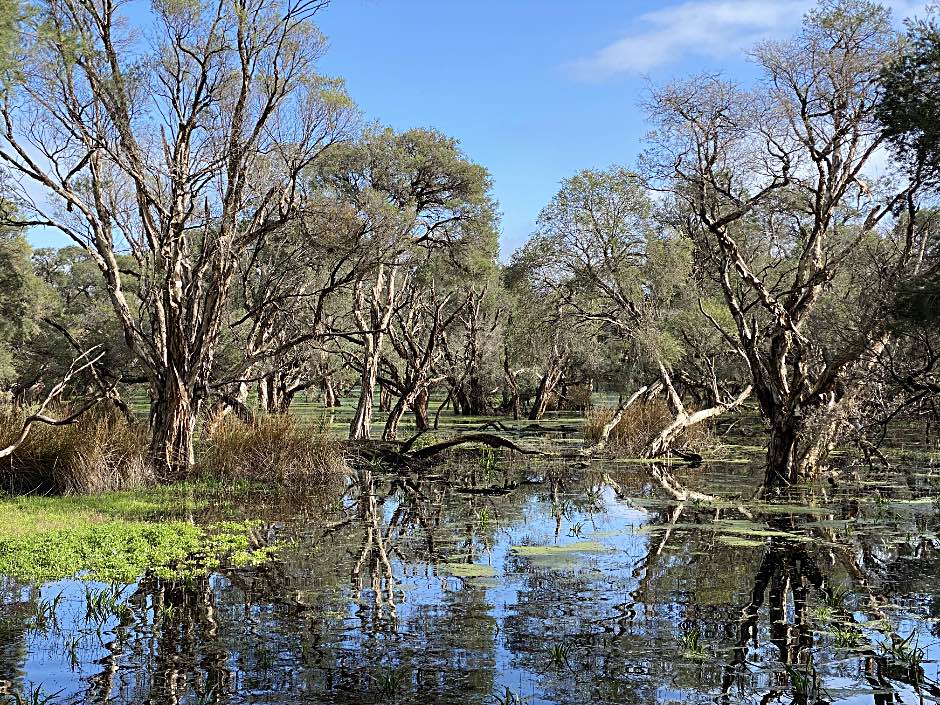
|
|
The BSPS with water in it. The duckweed can entirely cover the water by the end of the wet season.
Photo iPhone 11 Pro, focal length 6mm (telephoto), 2022/07/24 |

|
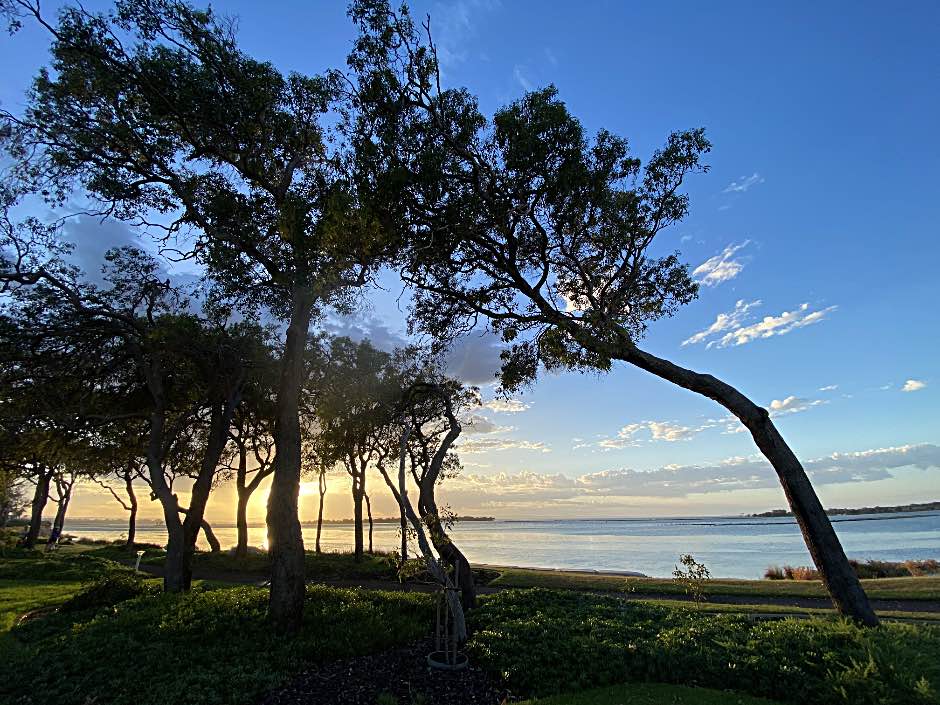
|
|
Sunrise over the Peel, seen from an early morning bike ride, a little to the north of Mandurah Quay.
Photo iPhone 11 pro, wide angle lens, 1.54mm, 2023/02/05 |
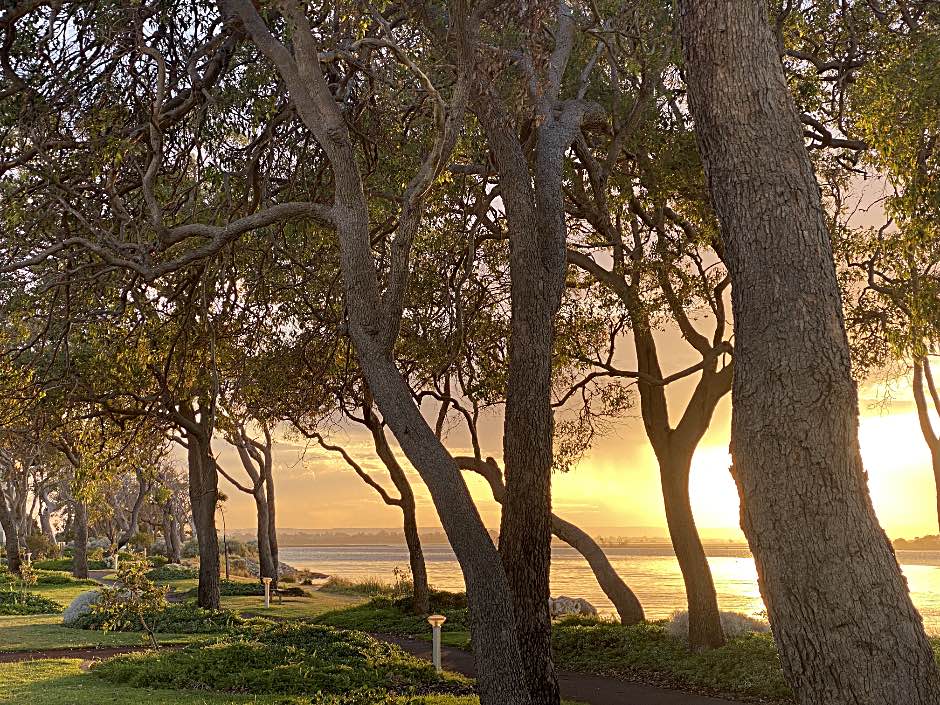
|
|
Again, sunrise over the Peel, seen from an early morning bike ride, a little to the north of Mandurah Quay and a very little further north than the previous image.
Photo iPhone 11 pro, telephoto lens, 6mm, 2023/02/05 |
East side of main channel, Soldiers Cove, Mandurah
There is a path along the channel for rather over half the distance between the two bridges.
Stingray Point fig tree, Mandurah |

|
|
The Mandurah foreshore area would not be the same without this magnificent Morton Bay fig tree (Ficus macrophylla).
The photo above, iPhone 11 Pro, standard camera, 4.25mm focal length. |
I captured these two images while on one of my early Sunday morning bicycle rides.
This tree was very sick for a time. Cormorants had taken to roosting in its branches in great numbers. I have not been able to find out exactly what made the tree sick, but I would suspect it would have either been the birds droppings onto the leaves or the excessive build-up of nutrients in the soil beneath the tree. One still sees some cormorants in the tree, but not the great numbers of some years ago. Wikipedia gives the year it was planted as 1899, while an article on the history of the Peninsula Hotel (which was once adjacent to the tree) give the year as 'around 1930'.
Photo iPhone 11 Pro, telephoto camera, 6mm focal length.
The Flinders Ranges, South Australia |
The Spirit of Endurance
|
|---|
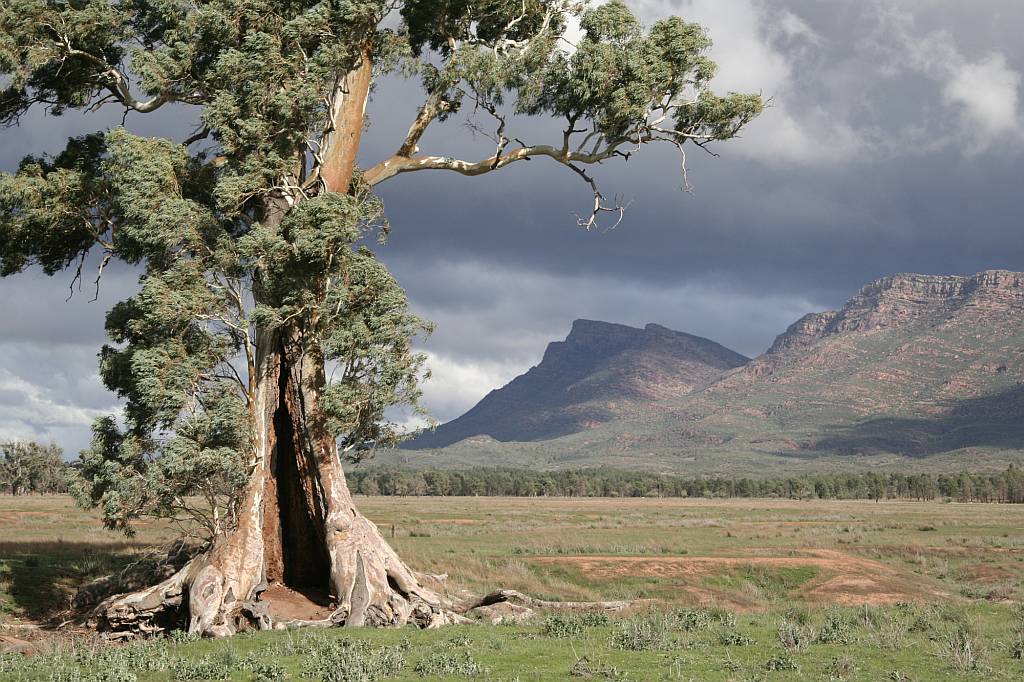
|
The Cazneaux Tree, famous for a photo by Harrold Cazneaux, taken 1953/06/19,
Art Gallery of NSW.
|
|
This photo was taken from a slightly different direction to that of Cazneaux's photo but both show a part of Wilpena Pound in the background. Remarkably, the tree seems to have changed little in the 61 years between the two images, other than growing more small branches near the base.
Gum trees usually only produce shoots from the trunk at times of severe stress. This photo was taken 2014/05/27.
This would be a River Redgum (Eucalyptus camaldulensis). River reds are common along water courses in the Flinders Ranges and similar environments through South Australia. |
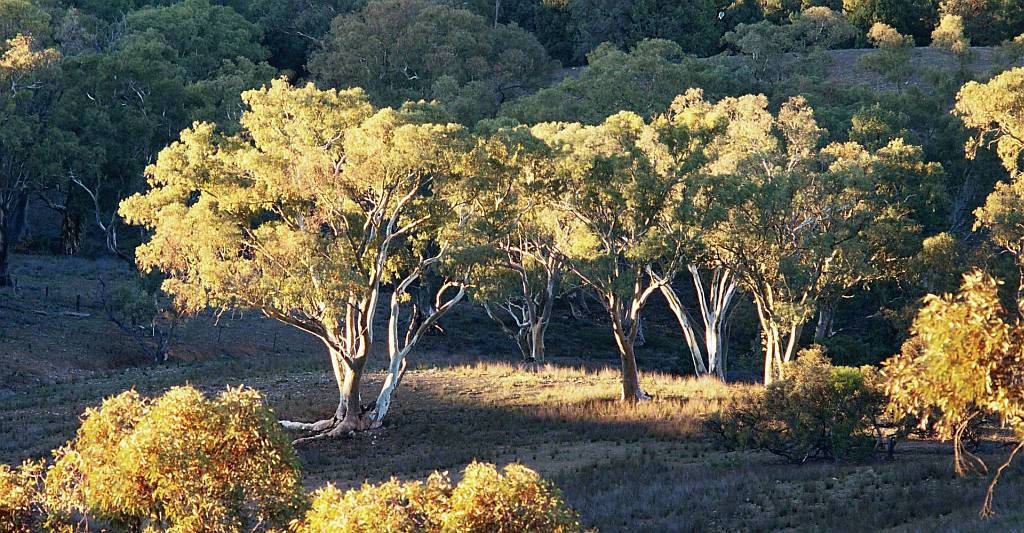
|
|
Early sunlight on gum trees at wilpena, a case of being in the right place at the right time. The original of this photo was on film, probably about 2005.
|
Callitris, common name native cypress pineCallitris trees (probably C. columellaris, common but somewhat misleading name, native cyprus-pine), are one of the defining features of the southern and central Flinders Ranges. Even more than with the magnificent Eucalyptus camaldulensis trees (common name river red-gum) the place would not be the same without them.
Where they are crowded together they are especially susceptible to drought. This photo was taken 2007/07/23. As of March 2020 the Callitris trees were suffering greatly from the drought that any reasonable person would have to at least partly ascribe to the effects of climate change.
Clare Valley of South AustraliaThe next two photos, taken by one of my drones, give a hint of how important Eucalyptus trees are in the Australian environment. The great majority of the trees in the two photos are Eucalypts. |
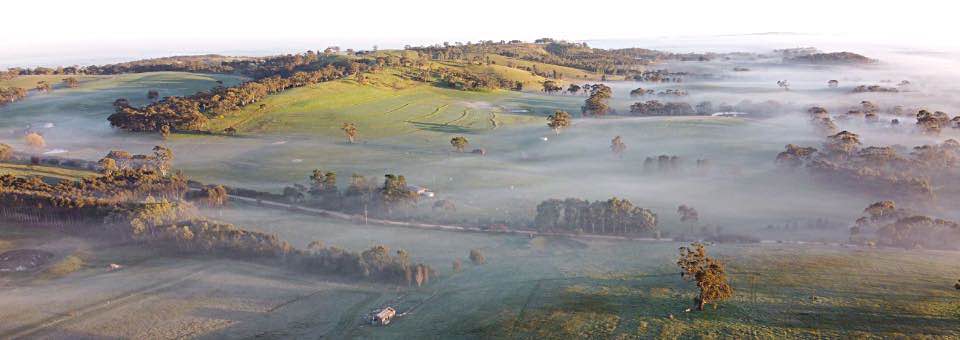
|
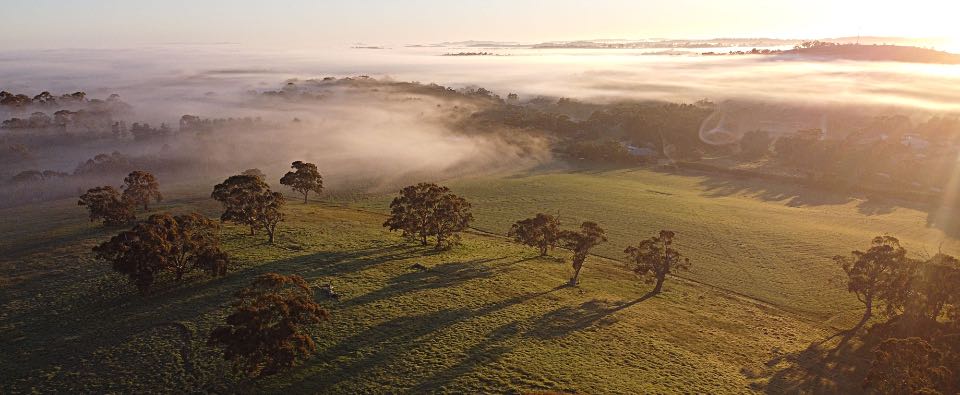
|
|
Looking northeast from the same point as the above image, Hicks Road is on the far side of the cleared paddock on the right. Armagh would be beneath the mist beyond that.
|
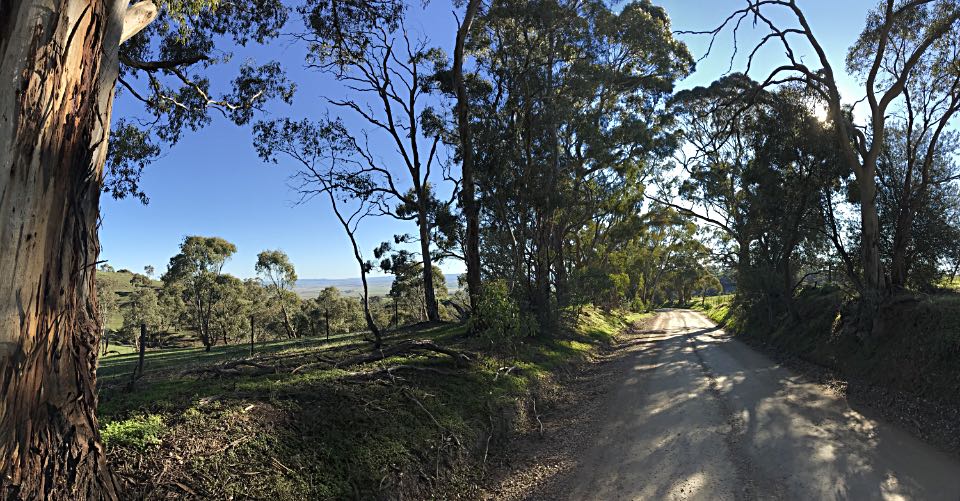
|
|
Jacobs Range Road, Armagh is west of Clare township,
From this section of Jacobs Range Road, near the southern end, you get views over the Blyth Plain.
Photo 2021/06/29, Apple iPhone 7, panorama |
Climate change hits the Clare Valley
The trees with the dead leaves in this photo are Red Stringybarks (Eucalyptus macrorhyncha). There are a few pockets of this species in the higher altitude and damper gullies of the Clare Valley. They are not endemic anywhere else in South Australia, but do occur in the eastern states.
I've written on another page about the poor condition of the vegetation due to drought at Willow Springs Resort in early 2020 in South Australia's Flinders Ranges.
Climate change hits the SW of Western Australia
|
|
|
|
You can report dead or dying trees in this citizen science project: The Dead Tree Detective, Western Sydney University.
Serious action on reducing emissions is desperately needed, but we are not seeing it.
CSIRO: Australia's changing climate; a quote...
"The drying trend is particularly strong between May to July over southwest Western Australia, with rainfall since 1970 around 20 per cent less than the average from 1900 to 1969. Since 1999, this reduction has increased to around 26 per cent."(I have expanded on the climate change problem, particularly as it impacts WA, on another page on this site.)
|
Sometimes, as in this case, it seemed to me that the propping of trees went too far to be aesthetically pleasing. But perhaps it was done for other than aesthetic reasons?
This was in the Kenrokumachi area, to the east of Castle Park.
Photo taken 2017/10/26
|
|
|
We only stayed in Narita for the night; we caught a morning train into
Tokyo where we met the rest of our family.

|
|
These magnificent trees (mountain ash, Eucalyptus regnans) and tree ferns (probably Cyathea species or Dicksonia antarctica) were in the mountains south of Marysville and north of Healesville.
The Yarra Ranges, and the adjacent Baw Baw Ranges to the east, are parts of the Great Dividing Range. |
Photo 2019/04/11
Another beautiful area of tall trees is the SW of Western Australia.
Tree ferns in the Yarra Ranges
Tree ferns like shaded places beneath taler trees, they can't handle the bright sunlight and heat of the open in Australia. They also need far more moist environments than are common in Australia. The tall gum trees in the image could be mountain ash (Eucalyptus regnans).
Photo iPhone 7, 2019/04/11, Yarra Ranges National Park, Fernshaw.
Marysville, in the Yarra Ranges area |
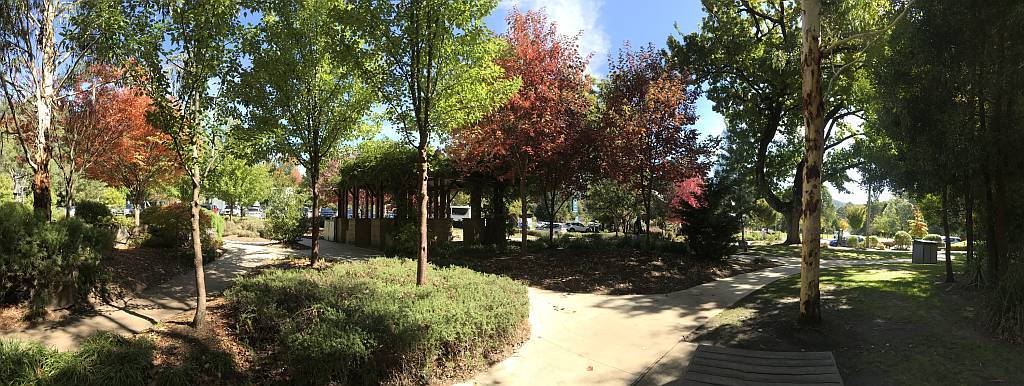
|
|
On our way from Eildon to the Latrobe Valley we took a short detour to Marysville to see the autumn foliage, which we had read is outstanding if you get there at the right time of year.
As it happened, we were probably a little early for the autumn foliage, but serendipitously, while we had a coffee break we happened to notice a sign to Bruno's Sculpture Garden. Photo 2019/04/11 |
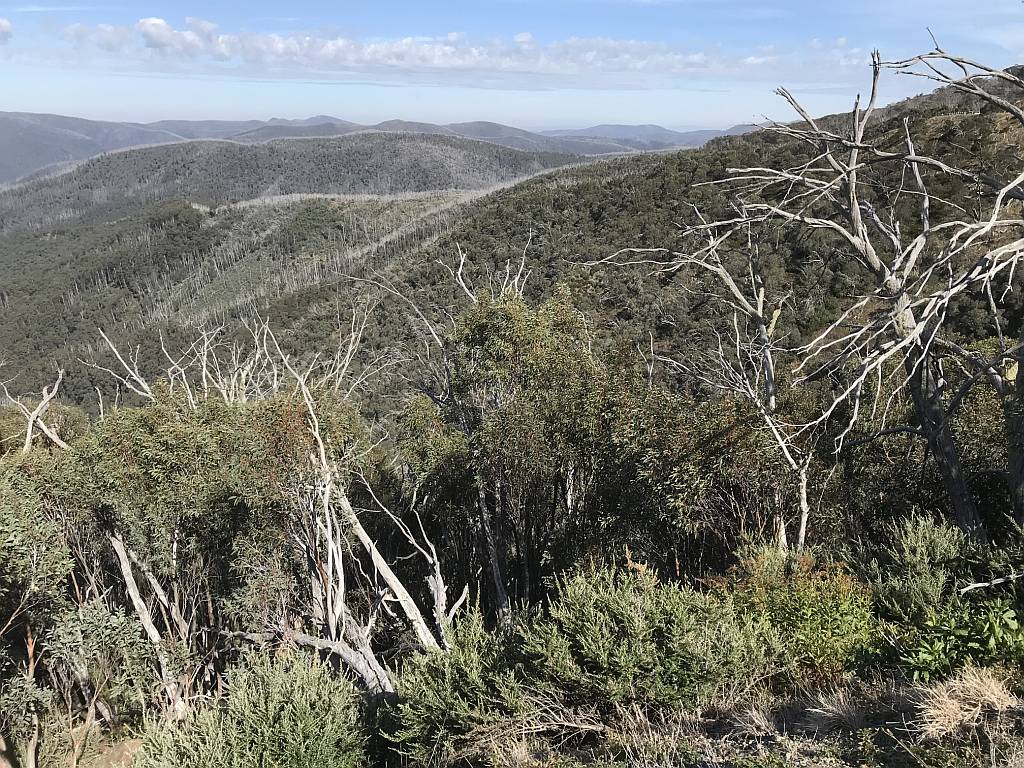
|
Photo 2019/04/18 This photo is taken from a page on a tour of a part of Victoria, including the Great Alpine Road and Hotham Heights.
How many thousand or million trees were burned in this fire? How many more intense and more frequent fires will 'our' Australian trees have to contend with in the future with climate change?
The King Valley, Great Dividing Range, Victoria |
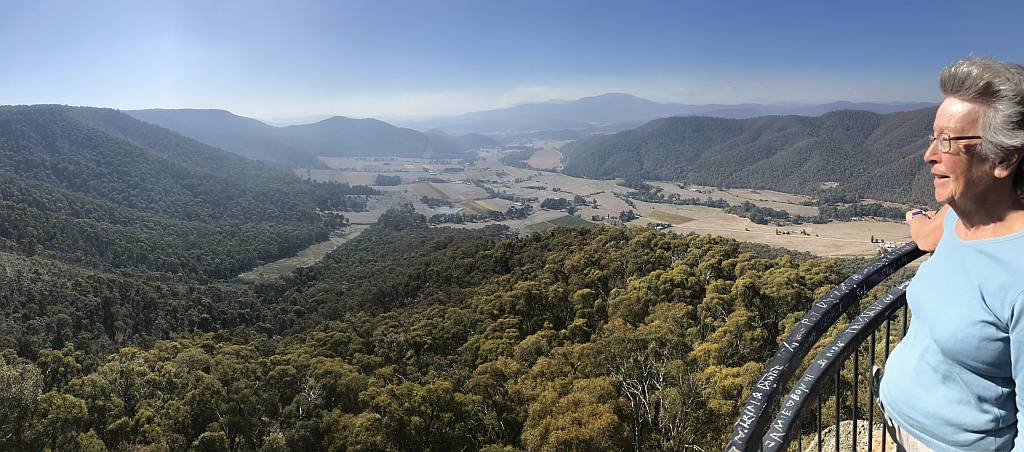
|
|
My wife, Denece, admiring the view over the King Valley. There is still big areas of forrest in the Great Dividing Range of Victoria and New South Wales, but how much of it is regrowth rather that untouched old growth is questionable.
The second lookout provides by far the better views. Photo 2019/04/20 |
Ouyen's mallee stump
It is certainly far, far bigger than any I had ever seen before. Mallee trees were cleared in their millions from what was to become farming land. The stumps made excellent firewood. Photo 2019/04/03 |
|
|
References/related pagesRelated pages on external sites...Some great tree photosRelated pages on this site...Perth: the good, the notable, and the uglyIncongruous: trees among the artificial world of buildings Climate change hits the Clare Valley South Australia's Flinders Ranges: here, here and especially here. Perth, WA: the good, the notable and the ugly If you care about our beautiful trees and you are Australian the best thing you can do is help get a Community Independent elected to parliament. The trees of the world are at risk as long as many of the politicians in the democratic countries of the world don't live up to their responsibilities and act with urgency on climate change. At the time of writing, the local member in my area, Andrew Hastie was a particularly irresponsible example. |
IndexOn this page...'Big seasonal paperbark swamp', MandurahClare Valley of South Australia Climate change hits the Clare Valley Climate change hits the SW of Western Australia Dead and dying trees East side of Mandurah main channel, Soldiers Cove Flinders Ranges, South Australia Introduction Hotham Heights, Great Alpine Road Japan Kings Park, Perth, WA The King Valley, Great Dividing Range, Victoria Mandurah Mandurah Quay area, Peel Estuary 'Big seasonal paperbark swamp', Mandurah Stingray Point fig tree, Mandurah Marysville, in the Yarra Ranges area Morton Bay fig tree, Mandurah Ouyen's mallee stump References/related pages Standing out from the crowd Tree ferns in the Yarra Ranges Yarra Ranges, Victoria Xanthorrhoea, a very atypical tree Xanthorrhoeas in the big seasonal paperbark swamp |